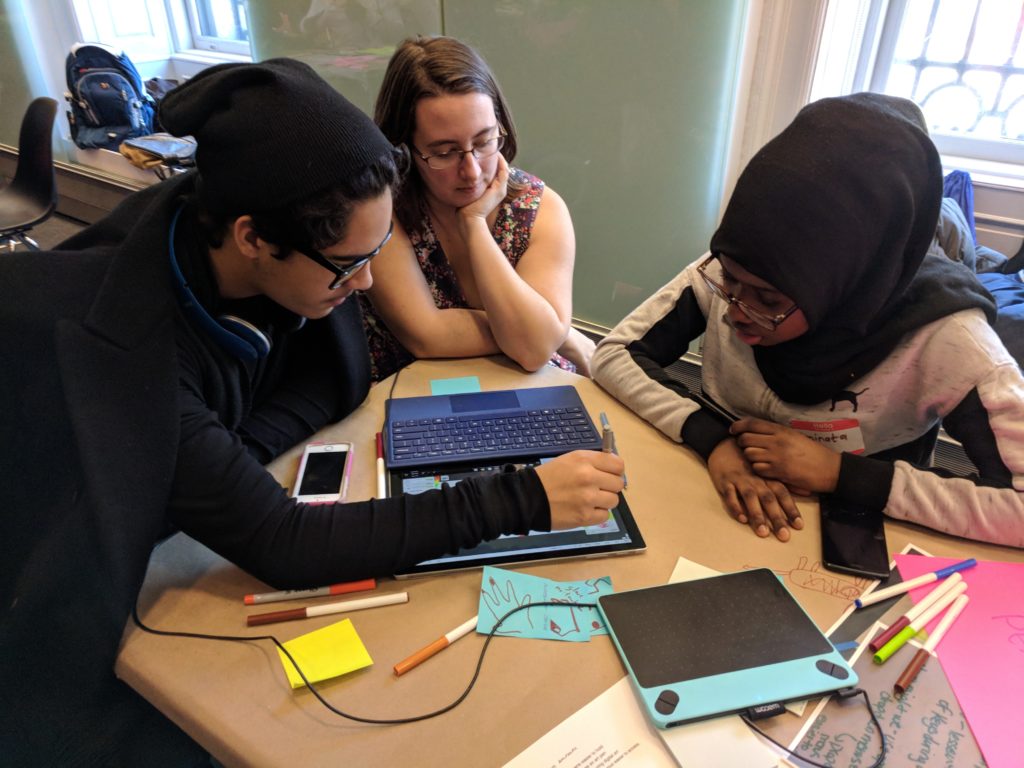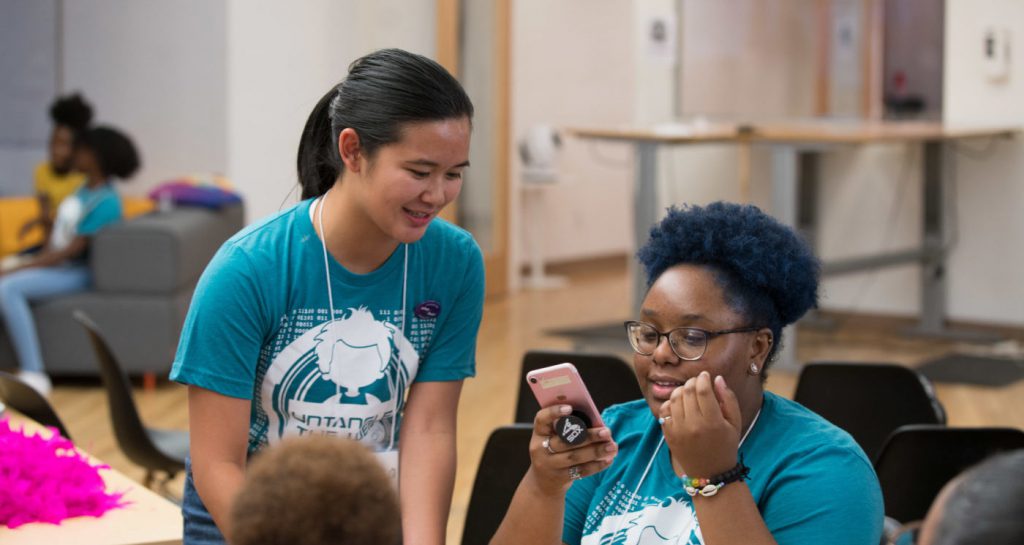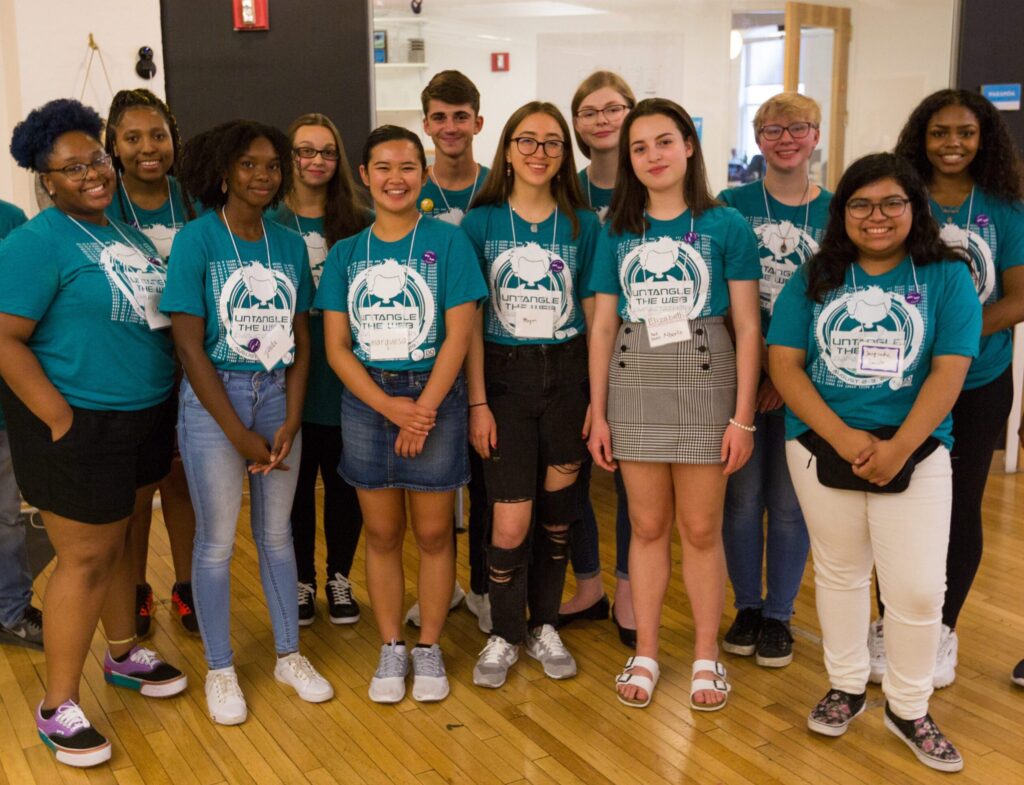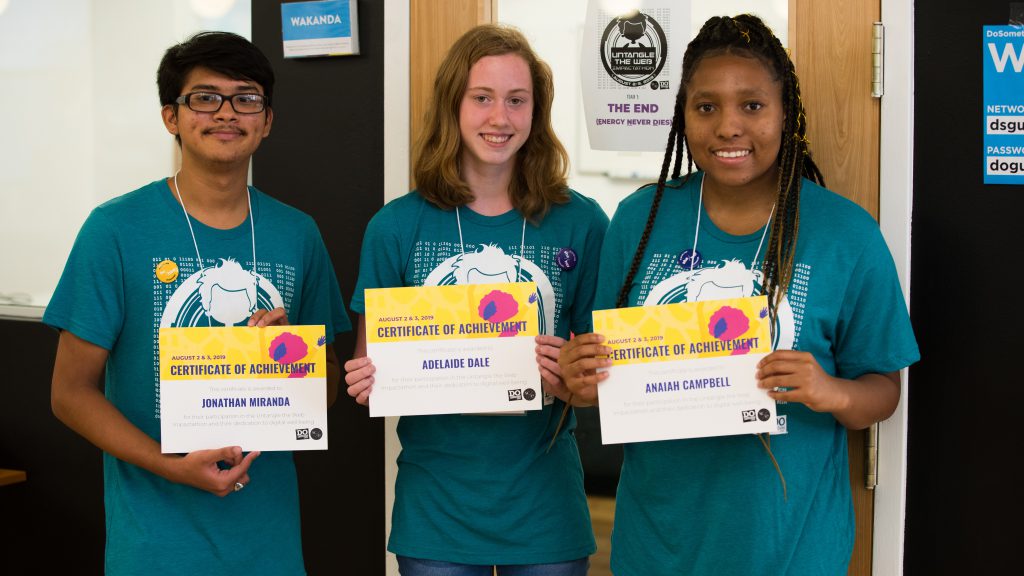Announcing SCE’s Youth Voice Challenge Partners
When we announced our Tech and Society Youth Voice Challenge last winter, we sought the answer to a single question: How can young people inspire their peers to use technology in healthy ways and make digital spaces better for everyone?
Six months later, the world looks completely different. COVID-19 has impacted the health and economic futures of millions. Across the United States, hundreds of thousands of people are marching to demand an end to police brutality and to state unequivocally that Black lives matter.
Our Youth Voice Challenge was never intended to directly address a global pandemic or racial injustice. But as our society goes through this period of transformative change, youth voice will be more important than ever.
With the future of in-person learning uncertain, young people are spending an unprecedented amount of time online. More than ever before, they’re using technology to connect with their families, peers, classmates, and online communities. And for the foreseeable future, technology will be how young people explore, discuss, and take action around critical issues.
In this context, young people need solutions that help them build positive and productive digital environments. Those solutions must be designed, tested, and implemented by youth themselves.
We’re proud to partner with nine exemplary organizations in search of youth-led solutions for a tech-enabled world. Each of our partners brings a unique approach to this work. All of them engage youth as leaders. Over the next two years, we’re excited to collaborate with this cohort, learn from their expertise, and share our learning with the field.
Read on to learn more about our Youth Voice Challenge partners.
Beam Center: Beam Center is a New York City-based makerspace that brings together youth, artists, engineers, and educators. Together, Beam Center program participants produce ambitious, collaborative projects that support youth to take bold steps towards meaningful futures and foster conditions for educational equity. To support a vision of digital public health for everyone, Beam Center will train and empower two diverse cohorts of young people to conduct their own research on Healthy Digital Futures. Their project will also support youth as they create a platform where they can share their findings with peers, youth-serving organizations and policymakers.
Digital Harbor Foundation: In 2013, Digital Harbor Foundation transformed a closed-down rec center in Baltimore into a vibrant Tech Center for youth. Since then, they have offered workshops and programs about technology and maker skills to both youth and educators. Digital Harbor’s project will provide approximately 40 Baltimore youth with the equipment, training, and mentorship to research, produce, and market their own podcast that discusses the most pressing technology issues they face today. Using this platform, youth will lead critical conversations about the role of technology in society.
Erikson Institute: Erikson Institute is a hub of complex, creative thinking that empowers adults to help children reach their fullest potential. They bring the newest scientific knowledge and theories of children’s development and learning into graduate education, professional training, community programs, and policymaking. Their project uses teen voices and experiences to research, develop, and implement a technology peer-to-peer mentoring program. It will honor and highlight youth perspectives and experiences, leveraging a strengths-based approach to supporting young people in healthy media use while building relationships between older and younger youth.
Games for Change: Games for Change empowers game creators and social innovators to drive real-world impact through games and immersive media. They convene industry experts through their annual Games for Change Festival, inspire youth to explore civic issues and STEAM skills through their Student Challenge, and showcase leading impact-focused games and immersive experiences through live Arcades for the public. Their project, Raising Good Gamers, will inspire young people to shape the culture of online communities, advance youth leadership and advocacy for safe, diverse, and inclusive gaming experiences, and build positive game communities that counter toxicity.
PeaceCasters: Based in Louisville, KY, PeaceCasters is a youth-led program housed within the Peace Education Program (Peace Ed) that empowers young people in middle and high school to share their stories with the world in order to create change through digital and social media. Through their groundbreaking Youth Influencers curriculum, they support young leaders to be influencers on social media and in their communities by sharing stories from lived experience, practicing positive communication skills, and building community online and off. Their curriculum is based on three pillars: empowered storytelling, social media for social good, and online conflict resolution. The PeaceCasters program builds on Peace Ed’s 37 years of experience training youth and adults to build and sustain positive relationships, bringing these essential skills into digital spaces and onto social media platforms.
Project Zero: Housed in the Harvard Graduate School of Education, the mission of Project Zero is to understand and enhance learning, thinking, and creativity for individuals and groups in the arts and other disciplines. Project Zero’s Reimagining Digital Well-Being will begin with empirical research that will help adults better understand the challenges that today’s youth face in their digital lives. Then, Project Zero will engage with youth in a participatory design project to develop a Digital Well-being Toolkit, which they will pilot and disseminate in partnership with youth-focused organizations.
Spy Hop: Spy Hop is a Salt Lake City-based digital media arts center offering in-school, after-school, youth-in-care, and satellite programming for students ages 9-19. Brave Voices, a youth-led participatory research, design, and media project, engages 400+ Utah youth in challenges, podcasts, and data storytelling to foster digital mindfulness and collective resilience. As digital auto-ethnographers, producers, and audiences, young people will create an open educational resource that shares both evidence-based insights and recommendations for building a better digital ecology.
Yale Center for Emotional Intelligence (YCEI): YCEI’s mission is to use the power of emotions to create a more equitable, productive, healthy, and compassionate society, today and for future generations. They conduct research and design educational approaches that support people of all ages in developing emotional intelligence and the skills to thrive and contribute to society. Their project will use a free program called InspirED to empower students to design and implement projects they believe best support healthy technology habits among their peers. Beyond the effects expected for participating schools, YCEI intends to promote these projects through its free website and share research findings about inspirED’s impact.
Youth Emerging Stronger (YES): YES’ mission is to provide runaway, homeless and foster youth (RHY) with safety, stability and housing, along with the relationships and resources to thrive now and in the future. They envision a world where resilient, self-assured, and hopeful youth are free from a life of homelessness and become capable of achieving positive, fulfilling futures. This youth-led project will help participants explore their own engagement with technology and ensure that their use of social media aligns with their long-term plans to enjoy academic and professional success. Once piloted, this project can be replicated for agencies serving runaway and homeless youth in Los Angeles and across the country.
Photo: student participant, Yale Center for Emotional Intelligence. © 2019. CASEL. All rights reserved.
How Can We Harness the Power of Tech?
This blog is the first in a series exploring our evolving thinking on the relationships between technology and society. We look forward to learning more about this emerging topic, and to sharing what we learn along the way.
Picture a typical weekday. If you’re anything like us, you check your phone within a few minutes of waking up. You’ve scrolled through Instagram or Facebook by the time you’ve had your morning coffee. You read an article or two on your way to work, where you’ll spend seven or eight hours on your laptop. You’ll message friends and family throughout the day, and when you get home you’ll look forward to winding down with an episode of your favorite show on Netflix (for us, that’s currently the Great British Baking Show).
It’s undeniable that technology is all around us. But the impact of that technology — how it’s affecting individual people and our society at large — is far harder to describe.
We think that it’s important to build positive and productive relationships with the technology we use every day. But how? And what does a positive, productive relationship with technology even look like?
It’s questions like these that inspired us to launch our Tech and Society program area, a new funding opportunity focused on youth voice, and a year-long design project to better define and understand this space. We’ve already done several months of research, partnering with great minds and inspiring organizations eager to learn more about this emerging issue. We’re excited to share what we’ve discovered so far.

We first dipped our toes into this issue area about two years ago. After eight years funding social and emotional learning and digital learning, we began to wonder how those two areas might intersect. How is technology influencing our relationships and individual and collective well-being? And how can people — especially young people — engage more thoughtfully with the technology that’s all around us?
In late 2018, we launched a partnership with Chicago Ideas designed explicitly to explore this space. Our collaboration kicked off with a series of focus groups with Chicago Ideas’ youth ambassadors. We asked these teenagers about various forms of digital citizenship, such as online privacy, freedom of speech, and critical consumption. Two things quickly became clear: 1) kids think about these concepts every day, and 2) digital citizenship only paints a partial picture of teens’ online lives.

Further work in this space confirmed these hypotheses. A second partnership with DoSomething.org layered in the concepts of youth voice and agency, and the next phase of our work with Chicago Ideas led to the development of a set of resources — including one focused on digital ethics — for young people seeking to engage more thoughtfully with online life.
The more we engaged with this space, the more complex we found it…. and the harder it became to define. We talked to kids, parents, nonprofit leaders, and other funders; everyone was interested in this issue, but nobody seemed to know quite what to call it or how to address it. Terms like digital citizenship, digital well-being, and screen time circled around the larger topic that interested us, but none of them fit quite right. We wanted to explore how human issues like identity, mental health, personal relationships, and many more were affected when filtered through the lens of technology. It’s a massive issue that we know far too little about, and it grows more urgent with every new advancement.
So we brought in some help. We partnered with a Chicago-based design thinking firm to help build a year-long project to convene the best and brightest minds in this space. Our goal was to give this issue a clear definition and framework, bring together the great thinkers already doing brilliant work, and build a movement to make tech work better for all of us.
In our next blog post in this series, we’ll share what we’ve learned from this process so far. Stay tuned!
Photos © Chicago Public Library, Digital Harbor, and Dreamyard / David Flores
We asked teens how to exercise better judgement online. Their responses blew us away.
“How might we improve people’s judgement in digital spaces?”
This was the question that guided the Untagle the Web hackathon, a two-day event we hosted this summer in collaboration with DoSomething.org. We gathered 15 exceptional young people who had expressed an interest in improving online life and asked them to develop a wireframe for a tool that would do just that.
Untangling the web
Last year, we partnered with DoSomething to develop Untangle the Web, a campaign designed to kickstart intergenerational conversations about digital life. DoSomething asked young people to take a quiz about how they used technology and media. Based on their responses, they received a digital personality and an action guide to help them start a conversation with an adult in their life. Whether a News Detective battling misinformation or a Ray of Sunshine spreading positive vibes, each young person shared an insight about their relationship with technology with a trusted adult.
Through this campaign, we aimed to reach 25,000 young people. Fifty-five thousand took the quiz.
Clearly, this project struck a chord with youth. We saw that young people recognized the effects that technology had on their lives and were desperate for resources that would help them navigate online environments.
Building on this momentum, we identified a small subset of the most engaged teens and asked them to apply for a hackathon—a two-day event where they could actually design a product that would help their peers untangle the web. We selected 15 of the most promising applicants from around the country and flew them out to New York City to participate.

Designing a mobile application to improve judgement in digital spaces. © DoSomething.org
The Hackathon
Working in small groups under the guidance of DoSomething mentors, these 15 teens developed wireframes for products that addressed our challenge question: “How might we improve people’s judgement in digital spaces?” They then presented their ideas to a panel of judges with diverse experiences in technology:
- Samarth Bhaskar, Senior Editor for Digital Transition Strategy, the New York Times
- Ross Dakin, adjunct professor of computer science, Lehman College
- Tej Gokhale, Civic Action Lead, DoSomething.org
- Jerelyn Rodriguez, co-founder, The Knowledge House
- Calvin Stalvig, Director of Youth Programming, Beam Center
We wanted to make sure our participants had plenty of space to develop their own ideas, so we only had a few requirements. Products had to be feasible, with a well-articulated problem, simple solution, and clear distinction from applications already on the market. They had to be functional, with a fleshed-out user experience. Lastly, they had to be integrated with existing online platforms.
Working in teams of three, our participants developed five product ideas:
- Thinklight: a chatroom that connects users with mental health professionals.
- ZiN: a bot that sends users daily affirmations that reinforce positive behaviors.
- VeriLegit: an application that uses existing databases to judge the accuracy of online media.
- HideOut: a service that clarifies who will see the personal information that users share.
- BullyBeeGone: a program that automatically hides and deletes abusive comments and messages on social media.

The 15 participants. © DoSomething.org
What did we learn?
This inspiring group of youth taught us so much about how young people today relate to technology. Here are our main takeaways.
- Young people want their voices to be heard. Over and over again, the young participants expressed appreciation that adults were making space for their ideas—and their leadership. Knowing that their voices are truly valued can encourage young people to get involved.
- These issues resonate with participants. The 15 young people we invited to the hackathon care deeply about online interaction. They also believe that online spaces could function better for young people—and that they’re perfectly capable of fixing them. These people were willing to spend a summer weekend working hard to make the internet better. They skipped their optional breaks to do it. And they designed five really, really impressive products.
- Diverse solutions empower more users. In the selection process, we prioritized participants that came from different geographies, races, socioeconomic backgrounds, and gender and sexual identities. This group clearly recognized that issues of online judgement don’t operate in a vacuum, and proposed solutions that took identity into consideration.
- Good online judgement means something different to everyone. We encouraged our participants to relate this topic to their own lived experiences. This allowed the cohort to focus on the specific issue or multiple issues that they felt were most pressing—and led to a diverse set of solutions. These participants didn’t necessarily agree on a single definition of “online judgement.” We think that’s a good thing. The one thing our participants did agree on? That it shouldn’t just be on them to exercise good judgement—tech companies have a responsibility to promote it.

The BullyBeeGone team. © DoSomething.org
What comes next?
Based on a set of criteria that included functionality, user experience, and potential for impact, our panel of judges selected BullyBeeGone as the official winner of the hackathon. Over the next few months, DoSomething will work with BullyBeeGone’s young designers to develop a minimum viable product (MVP) that will bring this great idea one step closer to the market. We’re excited by BullyBeeGone’s potential and thrilled that young people themselves are involved at every step of the design process.
Young people have really good ideas—and they’re willing to share them. It’s up to us to listen and to help them bring those ideas to fruition. In partnership with organizations like DoSomething, we’re striving to elevate youth voice and unlock young people’s potential as true agents of change.
We Untangled the Web with DoSomething.org. Here’s What We Learned.
More than 50,000 young people signed up to teach adults about digital life
Today’s young people are digital natives; they grew up with unmatched access to technology. However, they can feel disconnected from adults around technology and disempowered as members of the digital community. That’s a problem.
So what can we do? We know that fostering communication between a young person and an adult is critical for vibrant digital communities. So in March we partnered with DoSomething.org to kickstart intergenerational conversations about digital life. The goal was to reach 25,000 young people. After two months and more than 50 million social media impressions, 55,000 signed up to Untangle the Web.
Call to Action: DoSomething asked young people to take a quiz that asked them questions about how they use technology and media. At the end of the quiz, young people received a digital personality and an action guide curated to that personality to help them start the conversation with an adult in their life. Whether a News Detective battling misinformation or a Ray of Sunshine spreading positive vibes, each young person shared a piece of their life with those closest to them.
The Approach: Empower young people. DoSomething has found that operationalizing the “teach-to-learn” model by positioning young people as the experts has proven efficacy for behavior change and cause impact. They structured messaging around the positive behaviors they know young people exhibit online as an entry point to deeper conversation with adults about digital citizenship.
Youth Experiences: We think it worked. Thousands of young people shared their stories with us. Here are just a few.
With the help of this guide, I am informing my teachers and peers of better ways to sift through the tidal wave of information that the internet provides, and in turn, lead to more productive discourse.
“I love to have debates with my peers at school. We discuss politics, religion, and various other topics. However, it becomes very annoying when other students cite information from a website that either makes up and distorts common information, fails to provide any credible sourcing, or does not disclose funding sources. With the help of this guide, I am informing my teachers and peers of better ways to sift through the tidal wave of information that the internet provides, and in turn, lead to more productive discourse.” – Keaton, 17
This campaign is important to me because social media has made it so hard for people to be happy being themselves.
“This campaign is important to me because social media has made it so hard for people to be happy being themselves.The high expectations due to bullying and rude comments has completely taken over this generation’s ability to be happy in their own skin. People believe that they can say anything online without it affecting anyone just because it is not face to face, but that is not true. I know that I still remember every mean thing that has been said about how I look or my personality. I know that I am not the only one. The online harassment crisis needs to stop in order for people to be truly happy in their own skin again.” – Savannah, 18
“Before coming across DoSomething.org, I never noticed a problem with the way our society consumes media. But after exploring further, it became clear to me that discerning real from fake information online is a skill that even the most tech-savvy young adults lack. So I looked for ways to know which headlines, images, and quoted testimonies are legitimate. The solutions — learning to read horizontally, taking on the responsibility to ask ourselves two or three questions about the legitimacy of a source, and considering the consequences of what we post. I see these solutions as tips for improving the quality of information we intake online, key ingredients for an improved news diet. Doing this will not only improve our society’s media literacy but will contribute to a healthier democracy where we do not divide ourselves or argue on the basis of fake propaganda. These repercussions of media illiteracy must be acknowledged. And I foresee DoSomething’s effort to shed light on this largely disregarded issue impactful for youth and adults alike.” – Lina, 18
What We Learned
1. Through pre-campaign surveys, we learned that young people consistently rank online habits and digital use as one of the most important in their lives.
2. Post campaign, 66% of participants said they are more likely to talk to adults about technology as a result of their participation in the campaign.
3. Overwhelmingly, young people want to learn from their friends how to develop healthy skills online.
4. When asked to identify which skills are most important for navigating digital life, young people said Critical Thinking; Positivity, Compassion, and Suspending Judgement; Clear Communication; and Self-Control.
5. Young people want to be part of the solution. In fact, when asked what resources would be helpful, Accessible Content and Mentorship, More Online Resources and Guides, and Friends Learning from Each Other’s Mistakes were the most common suggestions.

What Comes Next
We heard our young people. Now it’s time to do something about it. Next, DoSomething and SCE are hosting an “Impact-A-Thon” in New York City from August 2-3. Fifteen young people will come together to solve a critical question: How might young people exercise better judgement in digital spaces?
So join us. Follow along. It’s an “Impact”-A-Thon, resource generation for young people, by young people.
Follow @scefdn and @dosomething on Twitter and Facebook for updates.
